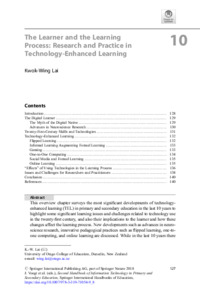The Learner and the Learning ProcessResearch and Practice in Technology-Enhanced Learning
Kwok-Wing Lai
Zu finden in: Second Handbook of Information Technology in Primary and Secondary Education (Seite 127 bis 142), 2018
  |
 |
 Diese Seite wurde seit 1 Jahr inhaltlich nicht mehr aktualisiert.
Unter Umständen ist sie nicht mehr aktuell.
Diese Seite wurde seit 1 Jahr inhaltlich nicht mehr aktualisiert.
Unter Umständen ist sie nicht mehr aktuell.
 Zusammenfassungen
Zusammenfassungen
 This overview chapter surveys the most significant developments of technology-enhanced learning (TEL) in primary and secondary education in the last 10 years to highlight some significant learning issues and challenges related to technology use in the twenty-first century, and also their implications to the learner and how these changes affect the learning process. New developments such as advances in neuroscience research, innovative pedagogical practices such as flipped learning, one-to-one computing, and online learning are discussed. While in the last 10 years there has been increasing focus on the learner rather than on the technology, mainstream research is still looking for technological impacts or effects on learning outcomes, and many adopt a rather deterministic view on the use of digital technologies in education. It is also noted that how innovative technology-supported learning environments can be scaled up and sustained is a major issue. Also, more attention needed be put on the psychological and emotional effects of TEL, as well as health and safety issues of digital technology use on the young learners.
This overview chapter surveys the most significant developments of technology-enhanced learning (TEL) in primary and secondary education in the last 10 years to highlight some significant learning issues and challenges related to technology use in the twenty-first century, and also their implications to the learner and how these changes affect the learning process. New developments such as advances in neuroscience research, innovative pedagogical practices such as flipped learning, one-to-one computing, and online learning are discussed. While in the last 10 years there has been increasing focus on the learner rather than on the technology, mainstream research is still looking for technological impacts or effects on learning outcomes, and many adopt a rather deterministic view on the use of digital technologies in education. It is also noted that how innovative technology-supported learning environments can be scaled up and sustained is a major issue. Also, more attention needed be put on the psychological and emotional effects of TEL, as well as health and safety issues of digital technology use on the young learners. Dieses Kapitel erwähnt ...
Dieses Kapitel erwähnt ...
 Personen KB IB clear | Richard E. Clark , Larry Cuban , Alberta Education , Thomas Fuchs , Anke Görzig , Leslie Haddona , Margaret L. Hilton , Robert B. Kozma , Kwok-Wing Lai , Sonia Livingstone , Tina Matuchniak , Seymour Papert , James W. Pellegrino , Marc Prensky , Larry D. Rosen , Neil Selwyn , Mark Warschauer , Ludger Wößmann | ||||||||||||||||||||||||||||||||||||||||||||||||||||||||||||||||||||||||||||||||||||||||||
 Begriffe KB IB clear | cognitive load theory (CLT) , microbloggingmicroblogging , One-to-One-ComputingOne-to-One-Computing | ||||||||||||||||||||||||||||||||||||||||||||||||||||||||||||||||||||||||||||||||||||||||||
 Bücher |
| ||||||||||||||||||||||||||||||||||||||||||||||||||||||||||||||||||||||||||||||||||||||||||
 Texte |
|
 Dieses Kapitel erwähnt vermutlich nicht ...
Dieses Kapitel erwähnt vermutlich nicht ... 
 Nicht erwähnte Begriffe | Ein Notebook pro StudentIn (ENpS), Notebooks an Schulen |
 Zitationsgraph
Zitationsgraph
 Zitationsgraph (Beta-Test mit vis.js)
Zitationsgraph (Beta-Test mit vis.js)
 Zeitleiste
Zeitleiste
 Anderswo finden
Anderswo finden
 Volltext dieses Dokuments
Volltext dieses Dokuments
 |  The Learner and the Learning Process: Research and Practice in Technology-Enhanced Learning: Artikel als Volltext bei Springerlink ( The Learner and the Learning Process: Research and Practice in Technology-Enhanced Learning: Artikel als Volltext bei Springerlink ( : :  , 272 kByte; , 272 kByte;  : :  ) ) |
 Anderswo suchen
Anderswo suchen 
 Beat und dieses Kapitel
Beat und dieses Kapitel
Beat hat Dieses Kapitel während seiner Zeit am Institut für Medien und Schule (IMS) ins Biblionetz aufgenommen. Beat besitzt kein physisches, aber ein digitales Exemplar. Eine digitale Version ist auf dem Internet verfügbar (s.o.). Es gibt bisher nur wenige Objekte im Biblionetz, die dieses Werk zitieren.


























 Biblionetz-History
Biblionetz-History